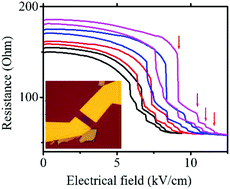Room-temperature electrically driven phase transition of two-dimensional 1T-TaS2 layers†
Abstract
Due to the strong electron–electron and electron–phonon interactions, the transition metal dichalcogenide 1T-TaS2 exhibits temperature dependent as well as electric field driven charge density wave (CDW) phase transitions (PTs). In this work, we investigate the thickness dependence of the electric field driven PT in 1T-TaS2 two-dimensional (2D) flakes. Electrically driven PT between high- and low-resistance states occurs at temperatures in the range of 60–300 K. For a thin 1T-TaS2 (≤8.8 nm) sample, only one PT is triggered, whereas thick films experience double PTs (13–17 nm) and multiple PTs (≥17.5 nm) until reaching the final low-resistance state. The multiple PTs may imply the existence of hidden nearly-commensurate charge density wave (NCCDW) states. In addition, a threshold electric field is observed, in which the low-resistance state is unable to resume the high-resistance state. Finally, we fabricate a 1T-TaS2/graphene hybrid field effect transistor to achieve a gate-tunable PT at room temperature. Such a hybrid device might provide a new avenue for the construction of CDW-based memories based on 2D materials.



 Please wait while we load your content...
Please wait while we load your content...